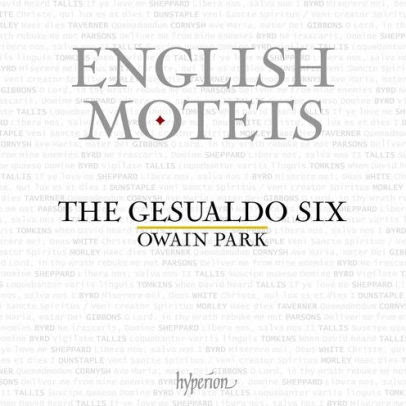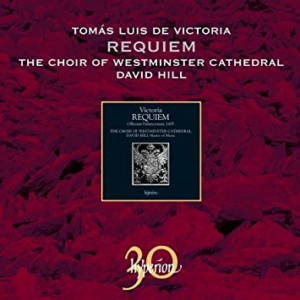Program: #18-16 Air Date: Apr 09, 2018
To listen to this show, you must first LOG IN. If you have already logged in, but you are still seeing this message, please SUBSCRIBE or UPGRADE your subscriber level today.
David Skinner’s “De Profundis” Ensemble, the latest from the Westminster Cathedral Choir, and a look at English motets by the ensemble The Gesualdo Six.
I. English Motets (The Gesualdo Six/Owain Park). Hyperion CD CDA 68256.

All of these composers were obliged to write in the musical style of the moment, which was constantly fluctuating in one of the most turbulent periods in English history. Lavish Catholic services required suitably elaborate music, with Latin words and rich sonorities. The Protestants did away with such excess, and as the walls were whitewashed so too was the music, with demands placed on composers to set English words as simply as possible, so that every syllable could be clearly heard by the congregation. Then, in Queen Elizabeth I’s reign, came a kind of relaxed simplicity, a halfway house, in which the ideal was both that the words could be heard clearly and also that the music should be interesting.
The enormous contribution to this period by Thomas Tallis and William Byrd is represented by the inclusion of three works from each composer, showcasing the versatility of their writing. While all composers in Tudor England were flexible to the period’s shifting religious requirements, none was quite as skillful at reinvention than Tallis, whose musical quality remains absolutely consistent, even while his style changes dramatically. Byrd gave voice to the plight of Catholics in England through many of his compositions, utilising his royal favour to escape punishment for his beliefs, and in doing so wrote some of the most enduring and powerful music of the era.
The presented order is not a linear journey, but a grouping akin to a concert programme, where a balance of fast and slow, similarity and contrast is all brought into play. The incredible productivity of composers writing during this period, coupled with the advent of printed sheet music and licenses granted for its production has resulted in a wealth of material available to us – and, as such, selecting only a handful of works to reside under the banner of ‘The English Motet’ was by no means easy. But I hope that we have managed to showcase something of the extraordinary journey composition took around the English Reformation, and in turn reflect our immense enjoyment in performing the music we all grew up singing.
Vigilate William Byrd (c.1540 – 1623)
Loquebantur variis linguis Thomas Tallis
When David heard Thomas Tomkins (1572 – 1656)
If ye love me Thomas Tallis
Libera nos I John Sheppard (c.1515 – 1558)
Christe, qui lux es et dies (I) Robert White (c.1538 – 1574)
O Lord, in thy wrath Orlando Gibbons (1583 – 1625)
Veni Sancte Spiritus John Dunstable (1390 – 1453)
Haec Dies Thomas Morley (1557 – 1603)
Quemadmodum John Taverner (c.1490 – 1545)
Ave Maria Mater Dei William Cornysh (dc.1502)
Deliver me from mine enemies Robert Parsons (1535 – 1572)
Ne irascaris Domine William Byrd
i. Ne irascaris Domine
ii. Civitas sancti tui
Libera nos II John Sheppard
II. Tomas Luis de Victoria: Requiem (Choir of Westminster Cathedral/David Hill). Hyperion CD CDA 30026.

'This goes to the head of the list of some fine versions of this requiem' (Fanfare, USA)
From Gramophone: Victoria's last publication was his six-voice Requiem Mass for the dowager Empress Maria, in whose service he had been from at least 1587 until her death in 1603. It is a wonderfully rich work, but at the same time one of his most restrained and refined compositions, including passages
from his earlier four-voice Requiem published in 1583. In his note to the Westminster Cathedral recording, Bruno Turner points out that it is a misreading to think that Victoria thought of this as his 'swan-song'; but every detail in the music declares it as the final summarizing statement of a glorious career....The differences are easy to hear. The Tallis Scholars use 12 singers, including five ladies; Westminster use a full cathedral choir with boys. The Tallis Scholars are slightly better at projecting all the details of the six-voice polyphony and have the edge on intonation as well as diction; Westminster produce a fuller, more expressive sound and give more weight to the changes in colour and movement in the music. Perhaps surprisingly, The Tallis Scholars produce a more convincingly Iberian sound, their sopranos finding it easier to project the open-throated quality that seems right for the music. At the same time, I would think that neither choir quite matches the hieratic austerity of the music. Victoria's largely homophonic sixvoice writing seems to suggest that he had in mind something massive and immensely slow reverberating in a rich acoustic ambience. Whether it is realistic to attempt such an effect in a modern recording is a moot question, but both recordings tend towards the sprightly.
Never have I been so perplexed in an attempt to establish my preference between two recordings. Often one brief passage seems better caught in one version where the very next passage is the other way round (particularly in the wonderful Libera me). Westminster usually find a slightly more passionate mood; but they tend to be somewhat less even in quality. (Why, for example, do the men have such soft consonants against the bright ones of their boys? I originally thought this was something to do with historical pronunciation, but there is no consistency here: both choirs tend towards 'standard Roman' pronunciation.) Readers may have their own preferences; but it is difficult to think that anybody would regret buying one as against the other.
2. Taedet Animam Meam Vitae Meae, 3:23
3. Ego Sum Resurrectio - Benedictus Dominus, Deus Israel Plainsong, 5:15
Missa Pro Defunctis (Requiem)
4. Introitus Requiem Aeternam Dona Eis, Domine, 6:52
5. Kyrie, 3:14
6. Graduale Requiem Aeternam Dona Eis, Domine, 3:04
7. Offertorium Domine Jesu Christe, Rex Gloriae, 5:19
8. Sanctus, 3:25
9. Agnus Dei, 3:51
10. Communio Lux Aeterna Luceat Eis, Domine, 4:43
11. Versa Est In Luctum, 5:22
12. Libera Me, Domine, De Morte Aeterna, 9:50
III. Ludford: Ave Maria, ancilla Trinitatis (Choir of Westminster Abbey/James O’Donnell). Hyperion CD CDA 68192.

O’Donnell treads a conservative path through the richly textured Missa Videte miraculum. In the Gloria the Lay Vicars create a luscious, serene opening which the treble voices later expand into a full six-part texture. The sound is wonderful, yet I notice they never fully capitalise on Ludford’s ecstatic cascades of imitative writing, notably at ‘Gratias agimus tibi’. There is a sense of some slight, almost statuesque withholding. Overall I find the treble sound more rounded than the Choir of New College’s Missa Benedicta (K617, 8/08); and although I have a lasting fondness for the metallic feistiness of Higginbottom’s choir, I do find that O’Donnell encourages really graceful long arced phrases from his trebles and maintains an overall more consistent tone. The finest singing on this disc, however, is undoubtedly Ave Maria, ancilla Trinitatis: an exceptional work and a superb performance. The choir are heard at their finest in the more impassioned moments, of which this votive antiphon offers many.
1 Kyrie [0'32] organ
2 Kyrie [0'27]
3 Kyrie [0'30] organ
4 Christe [0'30]
5 Christe [0'39] organ
6 Christe [0'30]
7 Kyrie [0'25] organ
8 Kyrie [0'34]
9 Kyrie [0'34] organ
Alleluia. Ora pro nobis [3'29]
10 Alleluia [1'10]
11 Ora pro nobis [1'01]
12 Ora. Alleluia [1'18]
Hac clara die turma [6'09]
13 Hac clara die [0'47]
14 Salutis causa, vitae porta [0'40]
15 Ave Maria, gratia Dei [0'44]
16 Virgo et gravida [0'37]
17 In me quomodo [1'01]
18 Ex quo atque nata [0'26]
19 Flatu sacro plena [1'08]
20 Intra tui uteri [0'46]
Ave Maria, ancilla Trinitatis [12'02]
21 Ave Maria, ancilla Trinitatis [4'23]
22 Ave Maria, doctrix apostolorum [5'48]
23 Et impetra nobis omnium [1'51]
Missa Videte miraculum [35'57]
24 Gloria [2'51]
25 Domine Deus, Agnus Dei [1'22]
26 Qui tollis peccata mundi, miserere [5'11]
27 Credo [0'40]
28 Visibilium omnium [3'18]
29 Et incarnatus est [1'41
30 Crucifixus [1'11]
31 Et resurrexit tertia die [3'55]
32 Sanctus [2'05]
33 Pleni sunt caeli [2'00]
34 Osanna [0'59]
35 Benedictus [3'19]
36 Osanna [1'21]
37 Agnus I [1'53]
38 Agnus II [1'46]
39 Agnus III [2'25]
Composer Info
Thomas Tallis (c.1505 – 1585), William Byrd (c.1540 – 1623), Thomas Tomkins (1572 – 1656, John Sheppard (c.1515 – 1558), Robert White (c.1538 – 1574), Orlando Gibbons (1583 – 1625), John Dunstable (1390 – 1453), Thomas Morley (1557 – 1603), John Taverner (c.1490 – 1545), William Cornysh (dc.1502), Robert Parsons (1535 – 1572), Tomas Luis de Victoria, Nicholas Ludford (c1490-1557))
CD Info
CD CDA 68256, CD CDA 30026, CD CDA 68192.